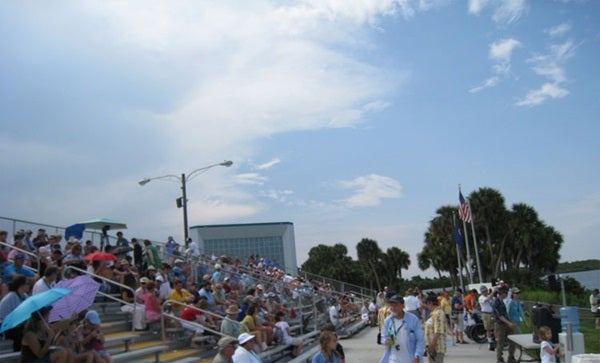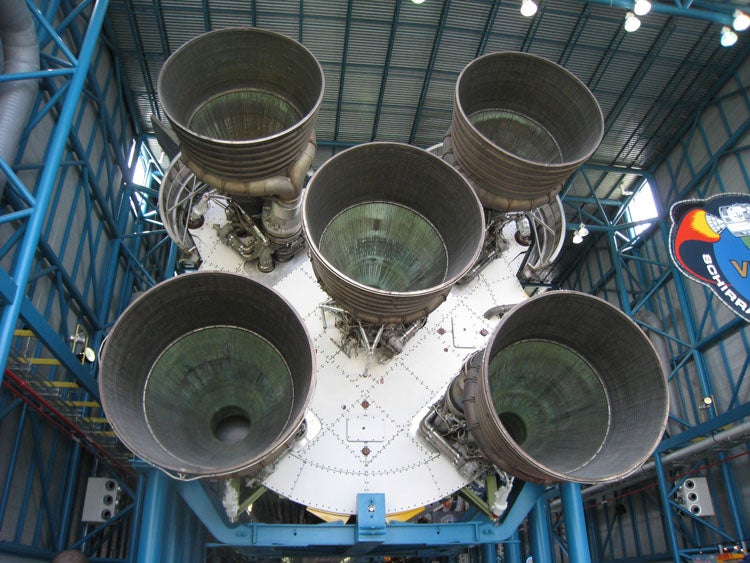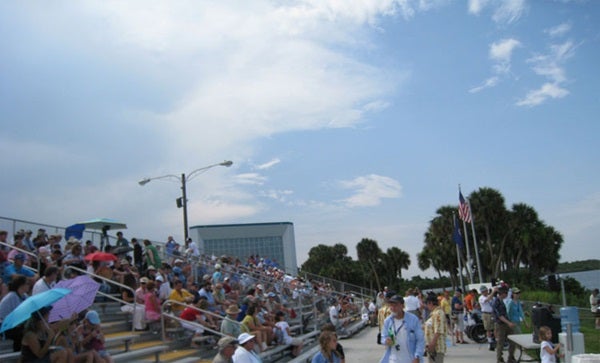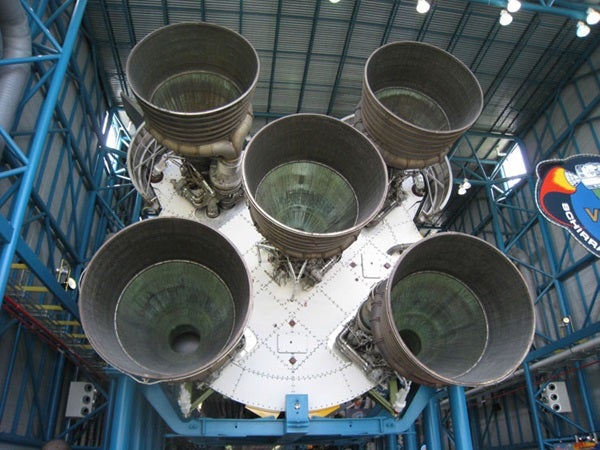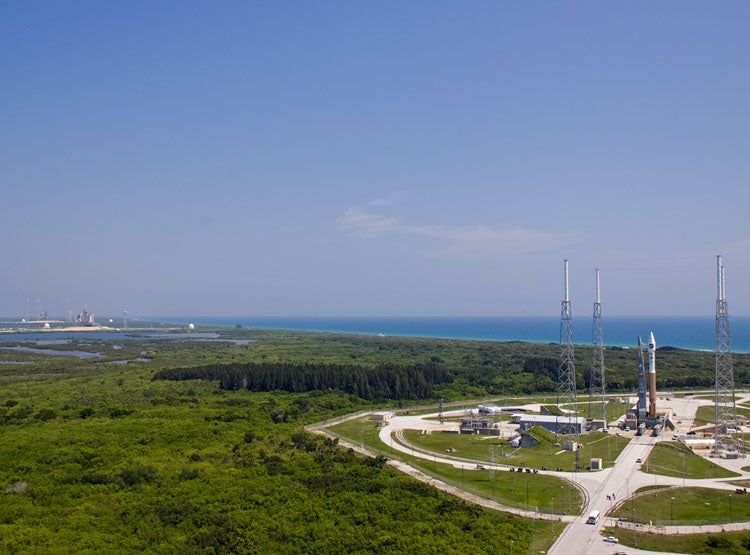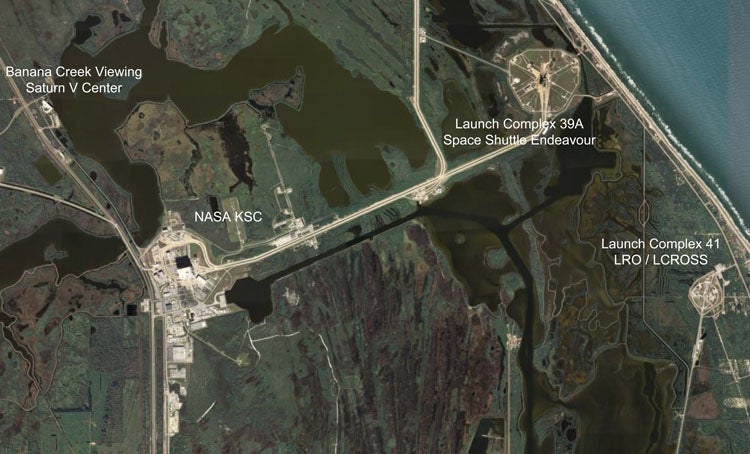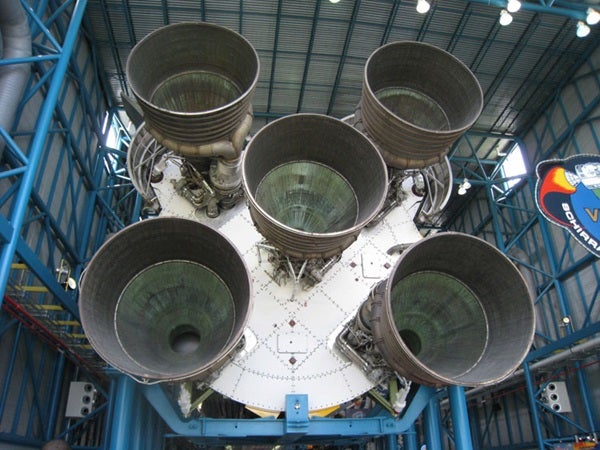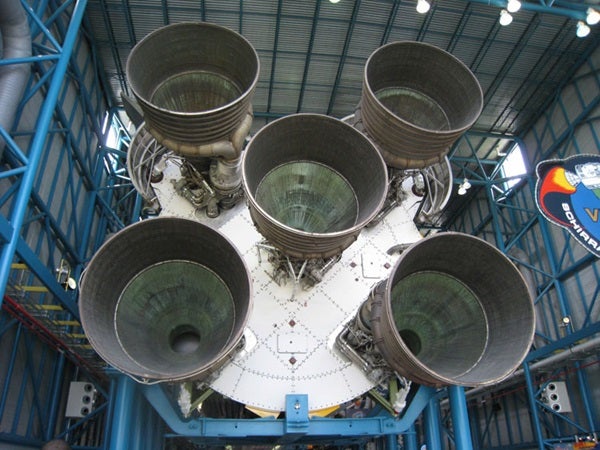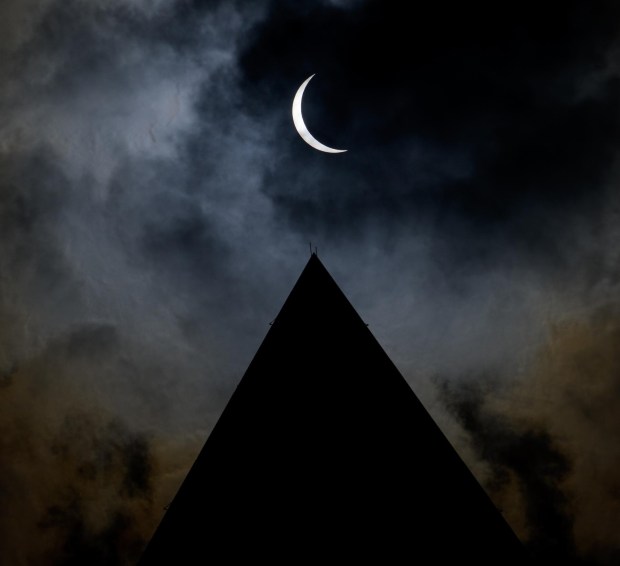Readers, we have liftoff!
OK, you already know that by now, but please excuse my lingering excitement days after the successful launch of NASA’s return to the Moon. I can’t help myself. It was simply amazing to witness the Atlas V rocket roar into the cloudy skies over Cape Canaveral, Florida, and hurtle the LRO spacecraft towards its lunar destination.
For a while there, we didn’t think it would happen. That’s because the first two launch windows, at 5:12 p.m. and 5:22 p.m., were slammed shut due to stormy weather. But this mission simply would not be denied! So, in the final time slot, at 5:32 p.m., we got the weather break we needed, and, well, the rest is history – or history in the making, if you like.
The LRO/LCROSS spacecraft is now on its way to the Moon, and we all await its arrival at our nearest celestial neighbor early Tuesday morning.
To see the launch, our group — which included graduate students at Brown University, my wife, my parents, and me — had to arrive early. Hours early. In fact, we got to the Banana Creek VIP launch-viewing site near the Saturn V center about 3 hours before launch. Everyone quickly staked out seats in the stands while others began setting up cameras with large telephoto lenses. To bide time and escape the heat, many people visited the Saturn V center. They marvelled at the enormous rocket that took astronauts to the Moon 40 years ago. It’s difficult to capture the entire length of the Saturn V in one picture, so I’ve included a close-up of the five giant engines in the first stage that would easily engulf someone standing inside them.
About a half hour before launch, the stands began to fill up. All attendees had their eyes on the sky, hoping that the clouds in the distance would not spoil our launch party. We were a little disappointed, and anxious, when the first two launch windows were scuttled. But then a message went out over the public address system that the Atlas V rocket was “green” to go. The crowd cheered. About 5 minutes before launch, we rose out of our seats as the Star Spangled Banner played. These are the moments when you feel fortunate to be witnessing history in the making. With about 30 seconds to launch, everyone began counting down to what we all came to see — 5, 4, 3, 2, 1! Liftoff!
The Atlas V lifted slowly off the launch pad, and even though we were miles away, we could see the fire and smoke billowing out beneath the rocket. I’ve included a picture taken by Brown University graduate student Kerri Donaldson Hanna who captured the lift-off.
It was eerily silent for several seconds as we watched the rocket clear the tower. Then came the sound, a thunderous roar that washed over us. Our eyes remained fixed on the rocket as it rose into the sky. And then — certainly too soon because we were all enjoying the show — the rocket shot through the clouds and out of sight.
We could still hear it, but it was above the cloud deck and on its way into space. Just like that. Before we knew it, the buses had started their engines, and we were on our way back to the Kennedy Space Center Visitor Center. Everything happened so quickly, but it was worth every second of waiting.
Over the next days and weeks, the Diviner group (you can read about our research in my earlier posts.) and the other instrument teams will watch as LRO reaches the Moon and begins to ease into a science-mapping orbit. Everyone is anxiously waiting for the first time the Diviner instrument is turned on and we begin to receive “first light” data. We had a great week of Diviner and LRO/LCROSS science team meetings, and we’re ready to start tackling the outstanding lunar science questions that these missions will help answer.
I’d like to thank the entire NASA LRO/LCROSS teams for a great week of science meetings and Astronomy.com for allowing me to share the excitement of launch week. I hope you enjoyed reading this blog, and stay tuned for science updates in the months and years ahead!
Amazing launch!
I’ll get some pictures organized tonight and share another update tomorrow morning.
Hope you enjoyed the launch.
Related:
We’ve had reports of thunderstorms. I’ll keep you posted
Greetings from the Banana Creek Viewing Center! Here is a picture of our group. Included are Brown University graduate students Angela Stickle, Kerri Donaldson Hanna, Debra Hurwitz, and Brendan Hermalyn. Also pictured are my wife Samantha and my mother and father, Elaine and Bruce Wyatt. We are standing in front of the viewing stands with launch pad 41 behind us and across the water. We’re all excited and keeping our fingers crossed for good launch conditions.
We are currently 2 hours from launch time!
Go LRO/LCROSS!
Today is launch day!
It seemed like this day would never come, but if all goes as planned (and weather permitting), LRO will launch at one of three times: 5:12 p.m., 5:22 p.m., or 5:32 p.m. EDT.
Hopefully we’ll be on our way to the Moon on the first try!
It almost goes without saying that the Diviner science team (see yesterday’s post below for what Diviner will study on the Moon), and indeed everyone associated with the LRO mission, is anxiously awaiting this afternoon’s launch. Yesterday morning, the orbiter was rolled out to Launch Complex-41 on Cape Canaveral Air Force Station and joined on top of the Atlas V rocket by the Lunar Crater Observation and Sensing Spacecraft (LCROSS). The pair tower, like giant needles, against a picturesque backdrop of sunny Florida skies and the blue of the ocean.
We will watch the LRO launch from the Banana Creek VIP launch-viewing site near the Saturn V center, which is only about 5 miles away from the launch pad (and as close as you can get for safety reasons). See the image at right I put together from Google Maps that shows the layout. You can bet that I will have my camera ready!
While the final preparations took place at the LRO launch pad, I gave a presentation back home in Rhode Island, so to speak. More specifically, I spoke by cell phone to third-to-sixth-grade students at Vartan Gregorian Elementary School in Providence, which was hosting a science conference organized by Brown University faculty and graduate students. While I would have liked to have been there in person, I think the students enjoyed getting live updates from someone on the ground. The youngsters asked some great questions, and who knows, maybe data from the mission will be used to choose a safe landing site for a future lunar astronaut and Vartan Gregorian alum.
Also yesterday, I popped over to some press conferences that NASA had staged for family and friends of LRO and LCROSS (which will seek for evidence of water ice by crashing a rocket into a permanently shadowed crater at the lunar pole). We heard presentations from NASA center administrators, mission managers, and scientists. It’s always humbling to stop and think about how fortunate we are to be working on a mission to the Moon. Years before I was selected to be a LRO participating scientist, mission engineers were busily designing, building, and testing the spacecraft and instruments. And none of this would be possible without the Atlas V launch vehicle. Speaking of, we heard a great presentation about the Atlas V yesterday at the press conference, and we are absolutely confident we’ll have a great ride to the Moon.
The press conferences, the last maneuvers of the vehicles into position – all that means the clock is ticking to launch time. This afternoon, we will board buses at the Kennedy Space Center Visitor Center to ride out to the viewing location. We must arrive at least three hours before launch time, so there will be plenty of downtime. If I have cell phone coverage, I’ll try to text some updates on how things are going.
Go LRO/LCROSS!
Related:
It’s turning out to be a busy, chaotic week at the Kennedy Space Center.
You would expect that, considering that NASA has two major launches scheduled. As I wrote about yesterday (see below), the space shuttle Endeavour was scheduled to launch early this morning, and everyone was brimming with anticipation. But NASA had to scrub the launch for a second time because of a leak detected in the gaseous hydrogen venting system outside the shuttle’s external fuel tank. These things happen, and it’s better to be safe than sorry, of course, but still it can be frustrating — most of all for those most closely involved in the planned flight.
So, Endeavour has now been moved back to July 11. The good news is that means the LRO launch has actually been moved up — to early Thursday evening. That’s tomorrow!
Now that we have a date and time, the meetings for the Diviner instrument (of which I’m a team member) and the other instruments are going gangbusters. The Diviner sessions are being led by Principal Investigator Dr. David Paige, a professor in planetary science at the University of California at Los Angeles. The team is a dedicated group of scientists and engineers with diverse backgrounds, which is what we will need to get the most science out of the data that we eagerly await. See the team in the picture at right.
A lot of people — including my own family and friends — are wondering why NASA is returning to the Moon. They ask, “Haven’t we already learned everything we need to know about the Moon from the Apollo missions?” They want to know, “Why are we going?” These are legitimate questions: After all, space missions are expensive, and taxpayers have a right to know how these missions benefit them — and humankind.
The first question is one that we as scientists can very clearly answer “No.” Thanks to Apollo, we have greatly increased our understanding of the origin, evolution, and current state of the Moon. However, Apollo’s six landed missions sampled only a very small portion of the Moon. Recent data indicate the lunar regolith (that’s the blanket of loose minerals, rocks and other materials on the surface, much of it produced by impacts) may vary greatly across different regions of the Moon. For comparison, imagine trying to fathom Earth by visiting only six places — it would be difficult, to say the least. Also, we need to address the distribution and abundance of potential water-ice deposits near the lunar poles. If these resources exist, they will be invaluable for future human missions. These are but a couple of the numerous scientific questions that LRO will help to answer about the Moon.
The second question extends beyond science. It’s about humanity’s innate desire to explore, to know more about who we are, where we came from, and who, if anyone, is out there with us. The Moon is our nearest celestial neighbor, and we still have a lot to learn from space exploration. If we can better understand the Moon, which records much of the history of the early solar system in its ancient crust, we can learn more about other planets in the solar system, including our own. That’s always a good idea!
After our meetings today, we have press conferences to attend with “friends and family of LRO.” It’s always great to see the excitement in children as they hear about the rocket launches and to meet the families of colleagues. My wife, Samantha, and my parents, Elaine and Bruce, were kind enough to join me in Florida this week to share in the excitement of the LRO launch. I’ll report back tomorrow with launch details if everything goes well. Keep your fingers crossed for clear skies!
Related:
Greetings from the NASA Kennedy Space Center! My name is Michael Wyatt, and I am an assistant professor in the Department of Geological Sciences at Brown University. I am also a participating scientist on the Lunar Reconnaissance Orbiter (LRO) mission. LRO represents NASA’s return to the Moon after mostly a decades-long hiatus and the first step in the agency’s goal of sending humans back to the Moon — and for an extended stay.
On the science side, we expect the LRO mission to collect an unprecedented amount of data. That trove of information should greatly expand our knowledge of the Moon and help us identify the best, and safest, landing sites for human missions. Some of the data we expect to gather are high-resolution images of potential landing sites, topography, and rock abundances to figure out where hazardous boulders are located. We’ll also be searching for lunar resources (hydrogen/water at the lunar poles and minerals) and characterizing the space radiation environment.
The Kennedy Space Center is a busy place this week. That’s because there are two major launches scheduled to occur within days of each other. The space shuttle Endeavour is slated to launch on Wednesday to the International Space Station, after its original launch on Saturday was scrubbed because of a leak associated with the hydrogen gas venting system outside the shuttle’s external fuel tank. This caused the LRO launch that was originally scheduled for Wednesday to be bumped to Friday.
Despite the delay, everyone is going about their business as you would expect: There are team meetings scheduled for each of the six instruments that will be aboard the lunar spacecraft. I am a participating scientist on the Diviner Lunar Radiometer Experiment (DLRE), so I will be mostly sitting in on those meetings. Diviner will provide orbital thermal mapping measurements, giving detailed information about lunar surface and subsurface temperatures (identifying cold traps and potential ice deposits), as well as variations in surface compositions and landing hazards such as rough terrain or rocks.
Related:

